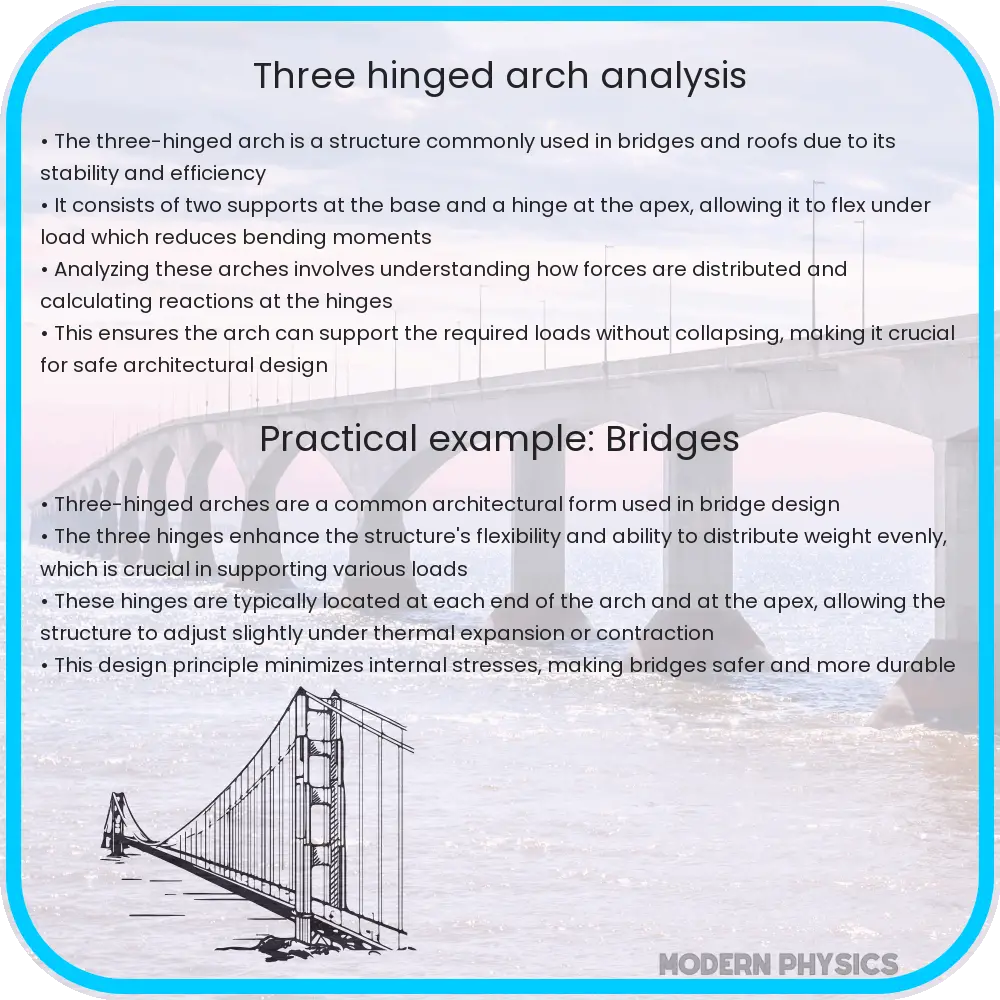Explore the mechanics of three-hinged arches, their load distribution, stability, and design with modern methodologies and iconic case studies.

Understanding Three-Hinged Arches: Load Distribution and Design Principles
The three-hinged arch is a fundamental structure in civil engineering, offering both aesthetic appeal and structural efficiency. This type of arch, characterized by three pivotal joints, provides unique advantages in load distribution, stability, and design flexibility. In this article, we delve into the mechanics of three-hinged arches, exploring how they distribute loads, their stability considerations, and key design aspects.
Load Distribution in Three-Hinged Arches
One of the primary features of a three-hinged arch is its ability to efficiently distribute loads. The hinges, typically located at each end and at the crown of the arch, allow it to undergo subtle movements. This flexibility enables the arch to adapt to various load conditions, distributing the weight more evenly across its structure. The central hinge plays a crucial role, acting as a fulcrum that balances the load between the two halves of the arch.
In analyzing the load distribution, engineers use the concept of the ‘line of thrust’. This imaginary line represents the path along which the resultant forces travel through the arch. For optimal performance, the line of thrust should remain within the middle third of the arch’s cross-section. If it deviates significantly, it can lead to tension issues and compromise the arch’s stability.
Stability Considerations for Three-Hinged Arches
Stability is paramount in three-hinged arch designs. The hinges provide a degree of freedom that, while beneficial for load distribution, can introduce challenges in maintaining structural integrity under various loading conditions. Lateral stability, in particular, is a critical factor, especially for longer spans or in regions with high wind loads or seismic activity.
To ensure stability, engineers must consider several factors during the design process. These include the material properties, the arch’s geometry, the type of load (static or dynamic), and the environmental conditions. A well-designed three-hinged arch should be able to withstand not only the vertical loads but also any lateral forces without undergoing excessive deformation or instability.
Design Aspects of Three-Hinged Arches
The design of a three-hinged arch is influenced by both functional and aesthetic considerations. Functionally, the arch must be capable of supporting the intended loads while complying with safety standards. Aesthetically, the arch should blend with its surroundings and fulfill the architectural vision. The choice of materials (steel, concrete, timber, etc.), the arch’s shape (parabolic, circular, catenary), and the construction methodology are all crucial elements that define the final structure.
Advanced computational tools and software play a significant role in the design process, allowing engineers to simulate various load scenarios and assess the arch’s response. This computational approach helps in optimizing the arch’s dimensions and material usage, ensuring a balance between structural efficiency and economic feasibility.
In the next section, we will explore specific design methodologies and examples of three-hinged arches, highlighting their applications and the innovative techniques used in their construction.
Advanced Design Methodologies for Three-Hinged Arches
Modern design methodologies for three-hinged arches involve sophisticated engineering techniques. Finite element analysis (FEA), for instance, is a powerful tool used to predict how the arch will react to different forces. FEA simulations help engineers in refining the arch’s geometry, selecting appropriate materials, and ensuring that the structure meets safety and performance criteria.
Another aspect of design involves considering the arch’s interaction with other structural elements. In many cases, three-hinged arches are part of a larger structure, such as bridges or roofs. Integrating the arch seamlessly with these elements is crucial for overall stability and functionality. This integration often requires innovative joint designs and careful consideration of load transfer mechanisms.
Case Studies and Applications
Three-hinged arches have been employed in various iconic structures around the world. A notable example is the Eiffel Tower’s arches, which demonstrate the elegance and strength of this design. In bridge construction, three-hinged arches are used for their ability to span large distances without extensive support structures, as seen in the Garabit Viaduct in France.
These structures not only stand as testaments to the architectural and engineering prowess but also offer insights into the practical applications and real-world performance of three-hinged arches. Studying these examples helps engineers and architects to innovate and push the boundaries of what is possible in modern construction.
Conclusion: The Future of Three-Hinged Arch Design
The three-hinged arch remains a popular choice in modern architecture and engineering, thanks to its aesthetic appeal and structural efficiency. The advancement in materials science and computational tools will continue to revolutionize the way these arches are designed and constructed. With a focus on sustainability, engineers are now exploring eco-friendly materials and methods to further enhance the appeal of three-hinged arches.
The blend of historical significance and modern engineering techniques makes the three-hinged arch an enduring symbol of architectural beauty and structural ingenuity. As we move forward, it is clear that these structures will continue to inspire and challenge the norms of construction, paving the way for innovative designs that are not only visually stunning but also environmentally responsible and structurally sound.
